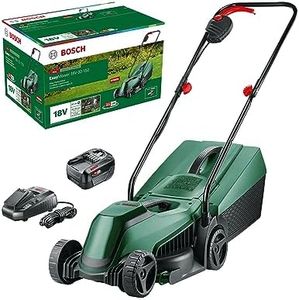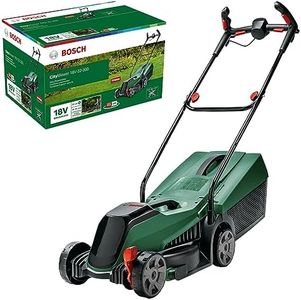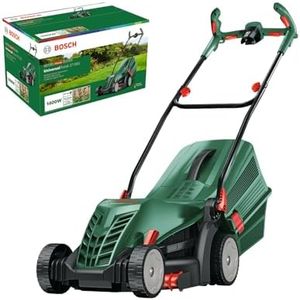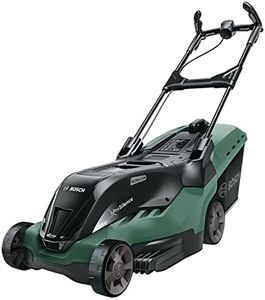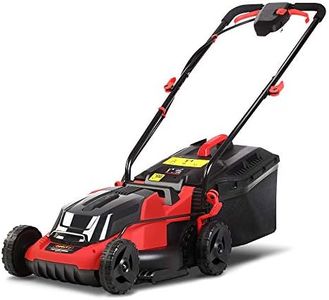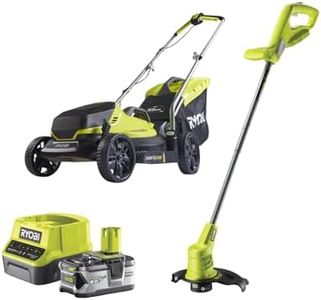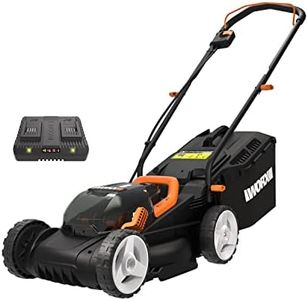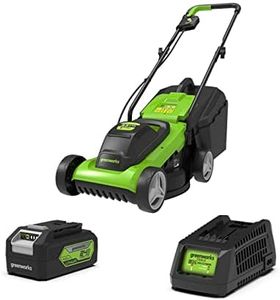We Use CookiesWe use cookies to enhance the security, performance,
functionality and for analytical and promotional activities. By continuing to browse this site you
are agreeing to our privacy policy
10 Best Electric Lawnmowers
From leading brands and best sellers available on the web.Buying Guide for the Best Electric Lawnmowers
Choosing the right electric lawnmower is all about matching the mower’s abilities to the size and type of your lawn. You want a model that will make mowing easy without being overkill or underpowered for your needs. Think about how much ground you need to cover, how thick or tall your grass usually gets, and how comfortable you want your mowing experience to be. Consider if you prefer using a cordless (battery-powered) or corded (plug-in) model, as this affects mobility and run-time. Once you’ve got a sense of your main needs, you can focus on specific features that will matter most for your yard and style of use.Power Source (Cordless vs Corded)The power source refers to whether the mower runs on a rechargeable battery (cordless) or must be plugged into an outlet (corded). Cordless models give you freedom of movement and are best if you have a larger yard or lots of obstacles, but you’ll need to make sure the battery lasts long enough for the whole job. Corded mowers never run out of power and are lighter, but the cord can get in the way, so they’re more suited to small, clear lawns. Decide how important unlimited run-time is versus ease of movement and pick the type that fits your typical mowing session.
Cutting WidthCutting width is a measure of how wide a path the mower can cut in one pass. Narrow widths (under 14 inches) suit small or irregular lawns and are easier to maneuver around tight spaces or flower beds. Medium widths (14–18 inches) offer a good balance of maneuverability and efficiency for medium-sized lawns. Wide widths (over 18 inches) can cover large, simple lawns quickly but may feel heavy or awkward in tight areas. Think about your lawn’s size and shape—a wider deck means less time mowing big, open spaces, but more careful handling near obstacles.
Battery Life (for Cordless Mowers)Battery life shows how long you can mow before needing to recharge. Short battery life (under 30 minutes) works for very small lawns, while medium life (30–50 minutes) suits most standard suburban lawns. Long battery life (over 50 minutes) is necessary if you have a bigger yard or like to mow in a single session. Always consider your actual mowing time and whether the battery can handle it; some models allow battery swapping, which can be useful if you need extra run time.
Adjustable Cutting HeightAdjustable cutting height lets you raise or lower the blades to change how much grass is cut off. Lower settings (1–2 inches) work for a neat, golf-course look, while higher settings (3+ inches) are better during hot spells or for thicker, more resilient grass. Look for mowers that are easy to adjust, so you can match the cut height to the time of year and the health of your lawn. If you have different types of grass or change your cutting routine, a wide range of easy adjustments is especially useful.
Grass Disposal (Bagging, Mulching, Side Discharge)Grass disposal refers to how a mower handles the clippings. Bagging collects grass in a container for easy cleanup—ideal if you don’t want clippings left on the lawn. Mulching chops clippings super fine and returns them to the soil, which helps feed your lawn naturally. Side discharge just spits clippings out to the lawn; it’s fastest but can be messy. Think about how much cleanup you want to do, whether you prefer a tidy look, and if you want the benefits of natural mulching. Some mowers offer more than one option for maximum flexibility.
Weight and ManeuverabilityWeight and maneuverability describe how easy a mower is to push and turn. Lighter mowers require less effort and are better for those who need something easy to handle—great for small yards, sloped terrain, or users who want minimal strain. Heavier mowers can feel sturdier and track better on large, flat lawns, but they’re tougher to move around obstacles. If you have lots of curves, trees, or flower beds, or just want an easier time, a lighter model is usually better.
Noise LevelNoise level means how loud the mower sounds when running. Quieter mowers let you mow early or late without disturbing the neighborhood and make the mowing experience much more pleasant. If sound is important to you (for example, if you have close neighbors or like to mow at odd hours), look for models with lower decibel ratings or those explicitly designed for quiet operation.
Ease of StorageEase of storage addresses how simply you can put your mower away when not in use. Features like folding handles or compact designs help if you have limited garage or shed space. If you know you need to store your mower in a tight spot, check how easily it can be folded or stowed away. Picking a model that fits your storage situation will make your overall experience less stressful.
